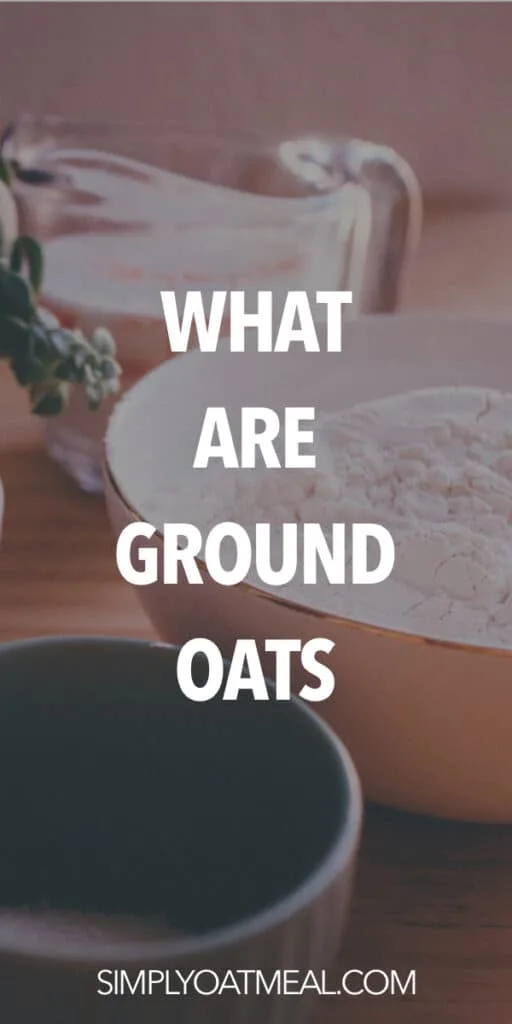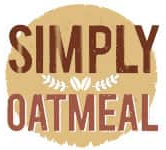Whether being used to brew beer or make a steaming hot bowl of porridge, oats have been a whole grain staple in the diets of humans former than 4000 years. With countless variations of processing, there are a number of oat products that are currently sold.
Raw oats are called groats or kernels, similar in size and shape to other cereal grains like rice and wheat. The oat groats are hulled to remove the inedible outer layer, and then cut, ground or rolled into all the other types of oats available for consumption.
So what are ground oats? Ground oats are raw oats that are ground into various shapes and sizes. Ground oats are boiled, steamed of used in baked goods.
This guide is going to detail specific questions about ground oats, what are the different grinds, how they are made and what are the best uses for ground oats. So, let’s dive in to understand everything there is to know about ground oats!
General Questions about Ground Oats
What are the most common kinds of oats? There are many stages to processing oats, beginning with the whole grain all the way down to finely milled flour. The most common are steel cut oats, rolled oats and quick oats, but here is a breakdown of some variations:
- Whole oat groats: the kernels that come out of the indigestible outer husk, after being harvested.
- Steel-cut oats: the oat groat is cut into 2 or 3 pieces using sharp steel blades. This reduces the cooking time and results in a product that is easier to chew and digest.
- Ground oats: occasionally called “meal oats,” “white oats,” “milled oats” and sometimes referred to as “Scottish oatmeal”, the oat kernels are stone-ground or milled with large rollers instead of cut. The resulting pieces are unevenly shaped and varied in size. How long the oats are ground will determine the outcome ranging from course grind to meal, porridge and lastly a powder.
- Rolled oats: once hulled, kernels are steamed and pressed into flakes using large heavy rollers, then dried in large kilns. The old fashioned oats are much easier to cook because they are flattened to expose more surface area. They have been partially cooked and are much thinner from the processing, therefore they take much less time to cook.
- Quick oats: steamed for long and rolled thiner than regular rolled oats. The oat flakes are not large and whole, but rather ultra thin, fragmented pieces.
- Instant oats: ground oats that are fully cooked and then dehydrated. The prepackage product is made to eat without cooking, just add boiling hot water a voila!
- Oat flour: oats ground into a fine powder are considered to be flour. Commercial manufactures grind oat flour using large industrial milling equipment, however you can make oat flour in a food processor or blender using rolled oats. For example, try these Oat Flour Waffles!
Are oats a grain?
Yes, oats are a cereal grain that are seeds from grasses very similar to barley, corn, rice and wheat. Legumes are also part of the same classification, however they have started to be considered in their own category.
Are ground oats the same as oat flour?
Yes and no, there are different sizes that result from the grinding process.
A popular type of ground oats is referred to as Scottish oatmeal, which has a large granule shape. Oats can be ground into medium grind is considered as meal, while further grinding results in a fine powder or oat flour.
Oat flour can be made at home by blending or pulverizing oats in a food processor. The resulting powder can be sifted and used to make a variety of hearty foods.
If you are following a porridge recipe, chances are you will need large chunks or flakes. However, baked goods generally require the use of fine powders or oat flour.
What is the best oatmeal brand?
Quaker brand oats are the leading manufacturer in the US, though there are many brand like Nature’s Path and Arrowhead Mills, but our favorite is Bob’s Red Mill. Read more about why we select it as the best rolled oats brand.
There are many popular oatmeal brands to choose from that value quality and consistency in their product, while also meeting customer demands for gluten free and organic options.
Ground Oats Nutrition


You will notice that there is very little difference between the nutritional values of Scottish oats and oat flour. The products are made from the same grain, the grind size being the only difference.
Nutrition is not lost when further grinding takes place. When the weights are the same, the nutritional value will be the same for all types of ground oats.
Do ground oats have carbs?
Yes, oats are carbohydrate-rich. The whole grains are a valuable source for fiber and complex carbs without any added sugars. As well, the contain healthy fats and plant based protein along with an array of essential vitamins and minerals.
In a 50 g serving of rolled oats, you’ll find:
- 170 calories
- 3 g of fat
- 33 g of carbs, of which nearly 3 g is fiber
- 5 g of protein
Are ground oats fattening?
Oats by themselves are not fattening. The whole grain is low in fat, therefore it is not imparting the fat content.
When observing oatmeal recipes, it was determined that the mix-ins and toppings were the contributing factor to making the dish fattening, not the oats by themselves.
Oatmeal is used to help maintain a healthy weight, reduce belly fat and it is also the primary food consumed in the oatmeal diet.
Oats help to suppress appetite and control hunger cravings which help to contribute to the use in weight loss.
While the data suggests that eating oatmeal in the morning initiate your metabolism and aid digestion, oatmeal can be eaten at anytime of day to promote a feeling of fullness.
Processed and conveniently packaged oatmeal products are not nearly as healthy as they are often coated with refined sugars, artificial additives, and other unhealthy ingredients that may taste great but often lead to weight gain and generally poor eating habits.
If you want to avoid gaining weight, opt for 100% oats with wholesome mix-ins and topping while staying diligent to portion size.
Is oat flour healthy?
Yes, oat flour is a healthy flour option.
Oat flour has more fiber, protein and essential nutrients than regular all-purpose wheat flour. Additionally, it has less carbs and is naturally gluten-free.
Ground oat flour is a good source of important minerals like copper, iron, magnesium, manganese, selenium, and zinc.
Can oats cause gas, bloating or constipation?
Yes and no. If you’re not used to digesting fiber-rich foods, they you may experience oats side effects when you first start eating oatmeal on a regular basis.
Oats can cause some indigestion until your body gets accustomed to the high fiber content.
Start by eating small portions to get your body used to digesting the oats. This will allow the bacteria in your gut time to adapt and build up adequate digestive enzymes in your gut.

Oats and Dieting
Are ground oats gluten-free?
If you are celiac or gluten intolerant, then oats are a gluten-free grain that is a great substitute for making baked goods without using wheat. Oats are not wheat, and do not contain gluten, therefore they have become a common addition to make gluten free recipes.
Due to the commercial manufacturing process, oats are typically harvests, processed and packaged in facilities that also handle wheat containing products. So if you are sensitive to wheat, then it’s important to look for the “gluten-free” label when purchasing oats in order to avoid cross contamination.
Are ground oats Keto?
No. Oats are over 70% carbs, so they are not beneficial to a low carb diet. Even a minute portion would completely deplete your allotted amount of carbs for the day.
Are oats Paleo?
No, the Paleo diet doesn’t allow grains. Oats are definitely a grain.
Are oats Vegan?
Yes, oats are vegan-friendly. They are a source of plant-based protein, fiber and healthy fats.
Are oats good for diabetics?
Oats are a fiber rich food that contains both insoluble and soluble fiber. The soluble fiber helps to regulate blood sugar levels by slowing the absorption of glucose and insulin.
Whole grain oats can help prevent and manage Type 2 diabetes when coupled with a well-balanced eating routine.
In order to receive this benefit of oats, you need to be conscious about what toppings and mix-ins you’re adding to your oats. Sweeteners, milk, and additional ingredients will negatively impact any advantages the whole grain might be providing.
How to Use Ground Oats
Ground oats have uses ranging from creamy porridge to silky smooth skin care. Included below are some of the ways you can use ground oats in your everyday routine.
How do you make ground oat flour?
Homemade oat flour can be made from rolled oats by using either a high speed blender or a food processor to pulverize the oats into a fine powder. Sift the large piece and continue to grind until the desirable consistency is reached.
It is recommended to use either quick oats or rolled oats to make oat flour. Steel cut oats are too large and dense to be processed this way, and may actually damage or distort the blades of the small appliance.
If you have a powerful electric grain mill grinder then you can use steel-cut or whole grain oats to retain a bit more nutrition since they haven’t been steamed at all.
How do you cook ground oats?
If you making porridge with ground oats, Scottish Oatmeal will give the granule consistency, otherwise select a meal grind or instant oats for creamer mouthfeel.
Boil 3 parts water to 1 part oats. Reduce to low heat and let simmer for 10 minutes before serving with your preferred milk, spices, fruits, nuts or favorite oatmeal toppings.
Oat flour is not an equal replacement for wheat flour. If you’re baking with ground oat flour as a substitution for regular all-purpose wheat flour, there are a few things you should be aware of. Oat flour is naturally gluten free, which means it doesn’t have the ability to trap gases, therefore the baked goods will not rise the same way that you’ll get with wheat flour.
Depending on the recipe, you may find the need to add a stabilizer such as Xanthan gum to avoid using a larger percentage of wheat flour. It’s best to stick to recipes that only call for oat flour, until you get familiar with the cooking restraints and expected outcome of baking with oat flour.
How to make overnight oats with ground oats?
Most overnight oats recipes call for rolled oats, but that doesn’t mean you can make the breakfast meal prep with ground oats instead.
Rather than experiencing the mouthfeel texture of chewiness, the resulting dish will be creamy and smooth.
When using Scottish Oatmeal, stick with a 2:1 liquid to oats ratio, including a pinch of salt and garnishing with in your favorite mix-ins.
When using ground oat flour, add the mix-ins just before serving to add a slight amount of texture to the dish. Give the oats a good stir, and you’ll find a smooth and creamy consistency that is similar to Cream of Wheat.
Can you eat ground oats raw?
Yes, you can. The ground oats are going to be much more palatable when they are soaked beforehand, but it can be blended into an oatmeal smoothie and drank like a cold porridge.
Ground oats for babies – is it safe?
Oats are commonly one of the first foods introduced to babies starting around the age of 6 months.
To make your oats as safe as possible for your baby, choose pure, organic oats and grind them into a fine powder to reduce any choking hazard. Whisk with water until smooth and naturally creamy, then serve as a thickened liquid in a bottle or spoonable porridge.
Can you use ground oats for skincare?
There are a number of benefits to using oats in a natural skincare routine including moisturizing the skin while reducing oiliness on the surface. The natural antioxidant provides anti-inflammatory power to improve skin tone and lessen acne.
Place a cup of oats in a cheesecloth pouch and fill a bathtub with warm water. Additionally, you can form a paste with ground oats to make a face mask.
